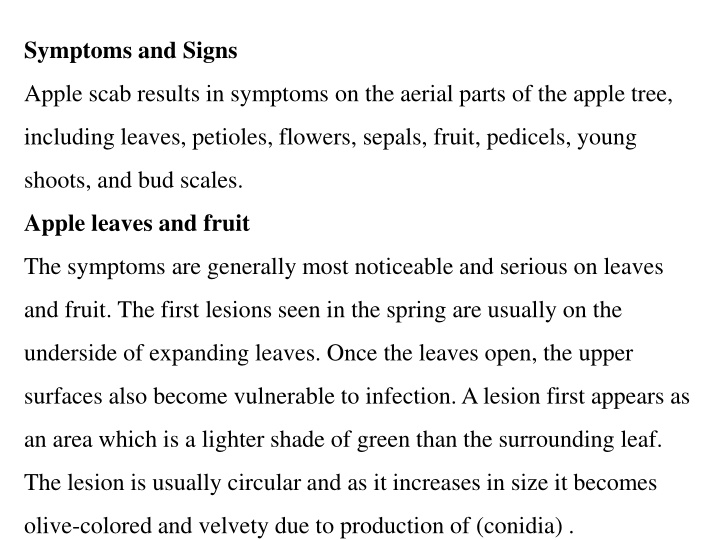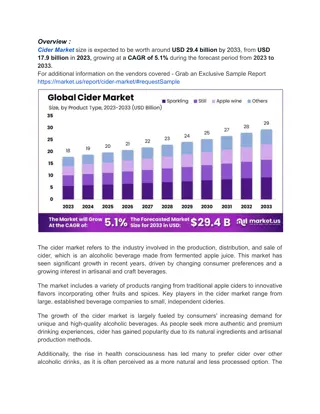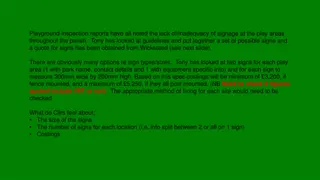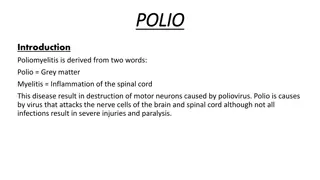Symptoms and Signs of Apple Scab
Apple scab is a fungal disease affecting various parts of the apple tree, resulting in characteristic symptoms like lesions on leaves and fruit, water-soaked areas on fruit, and potential defoliation. Understanding the life cycle of the causing fungus V. inaequalis is crucial for management strategies.
Download Presentation

Please find below an Image/Link to download the presentation.
The content on the website is provided AS IS for your information and personal use only. It may not be sold, licensed, or shared on other websites without obtaining consent from the author.If you encounter any issues during the download, it is possible that the publisher has removed the file from their server.
You are allowed to download the files provided on this website for personal or commercial use, subject to the condition that they are used lawfully. All files are the property of their respective owners.
The content on the website is provided AS IS for your information and personal use only. It may not be sold, licensed, or shared on other websites without obtaining consent from the author.
E N D
Presentation Transcript
Symptoms and Signs Apple scab results in symptoms on the aerial parts of the apple tree, including leaves, petioles, flowers, sepals, fruit, pedicels, young shoots, and bud scales. Apple leaves and fruit The symptoms are generally most noticeable and serious on leaves and fruit. The first lesions seen in the spring are usually on the underside of expanding leaves. Once the leaves open, the upper surfaces also become vulnerable to infection. A lesion first appears as an area which is a lighter shade of green than the surrounding leaf. The lesion is usually circular and as it increases in size it becomes olive-colored and velvety due to production of (conidia) .
Lesions that form on young leaves may be quite large, some more than 1 cm in diameter. Lesions that form on expanded leaves are usually smaller because older leaves are more resistant to infection. Affected tissues eventually may become distorted and puckered, and the leaf lesions often become cracked and torn. Lesions on the leaves and fruit are generally blistered and "scabby" in appearance, with a distinct margin .
The earliest noticeable symptom on fruit is water-soaked areas which develop into velvety, green to olive-brown lesions. Infections of young fruit will cause fruit distortion . Severely infected leaves or fruit will often drop from the tree. Infection which causes significant defoliation for two or three years in a row can result in weakened trees that are more susceptible to freeze damage, insect injury, and other diseases.
Life cycle of V. inaequalis In the spring, at the time the apple buds are bursting, the fungus begins its life cycle by forcibly ejecting its ascospores, through the openings of ascocarps buried in the tissues of dead apple leaves lying on the ground. The ascospores are two-celled, yellowish with the upper cell shorter and somewhat wider than the lower (H). The unequal size of the two cells of the ascospores gives the species its name. Air currents lift the ascospores to the apple leaves on the trees, and germination occurs in the presence of moisture (I).
The germ tubes issuing from the ascospores penetrate the cuticle, and the mycelium begins to grow forming a thin, subcuticular stroma. A few days after infection, numerous short conidiphores (B) break through the cuticle and each produces a flame-shaped conidium at the tip, so that conidiophore and conidium resemble a short burning candle. Conidia are spread by rain to other leaves or to young fruits in various stages of development; the fungus propagates itself asexually throughout the spring and summer, producing several conidial generations. Late in the season when the leaf cells begin to die, the mycelium penetrates deep into the leaf tissues and proceeds to form ascocarps as follows:
When coil in a hypha consisting of uninucleate cells initiates the formation of the stroma. As this develops, a coil of multinucleate cells representing the ascogonium differentiates inside the young stroma, and a trichogyne pushes through and protrudes from the stromatal wall (E). In the same time, an antheridium is formed from a hypha of the opposite strain and contact is soon established between the antheridium and the trichogyne. The antheridium nuclei pass into the ascogonium through the trichogyne (F). The nuclear pairs pass into the ascogenous hypha, which now develop from the lower portion of the ascogonium (G). Ascus formation takes place, and the stroma continues to develop and form the ascocarp (H). The ascospores mature inApril or May depending on the locality.























